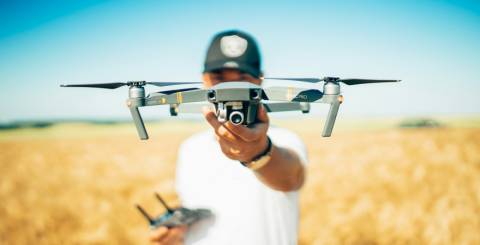Why Is Hands-On Training Essential for Drone Pilots?

In today’s fast-paced drone technology landscape, hands-on training, like the programs provided by iDrone Train, has become essential for aspiring pilots. Mastering the complexities of drone operation requires more than theoretical knowledge; practical experience is key to ensuring safety and efficiency in the field. This article explores the vital role that hands-on training plays in developing skilled drone pilots, highlighting its impact on performance, safety, and regulatory compliance.
Importance of Hands-On Training
Hands-on training is crucial for aspiring drone pilots, enhancing their operational skills and ensuring safety during flight. Practical experience directly contributes to a pilot’s ability to manage real-world challenges.
Read more: Coding Adventures in the Sky: Unveiling the Excitement of CoDrone Projects for Kids
Improving Pilot Proficiency
Improving pilot proficiency hinges on practical experience with drones. Practising flight operations under varied conditions helps pilots refine their skills, such as navigation, obstacle avoidance, and emergency handling. Engaging in simulated scenarios allows pilots to face potential challenges without the risk associated with actual flights. The repetition of essential manoeuvres leads to increased accuracy and efficiency, preparing pilots for real-world applications.
Building Confidence in Flight
Building confidence in flight is essential for drone pilots. Hands-on training fosters familiarity with the equipment and controls, reducing anxiety during operations. As pilots gain experience managing different flight scenarios, their ability to respond calmly in stressful situations increases. This confidence extends to adherence to safety protocols and regulations, further enhancing operational success. Regular practice turns novice pilots into competent operators, ready to tackle any challenge in their flight path.
Key Advantages of Practical Training
Practical training offers significant benefits for drone pilots, enhancing their overall competency and operational readiness.
Real-World Experience
Hands-on training provides essential real-world experience that theoretical learning cannot match. Pilots encounter actual flight conditions, weather changes, and environmental factors, which improve their understanding of drone behaviour. This exposure equips them to make informed decisions during flights. For instance, understanding how to navigate around obstacles in unpredictable surroundings directly results from practical experience. Engaging with different terrains and scenarios leads to quicker adaptation and improved situational awareness, crucial for successful operations.
Enhanced Problem-Solving Skills
Practical training sharpens problem-solving skills necessary for effective drone operation. Pilots practice responding to various challenges, such as system malfunctions and unexpected obstacles. This practical approach fosters critical thinking, enabling pilots to assess situations rapidly and implement solutions. For example, practising emergency protocols during training helps pilots develop confidence in their ability to manage crises. Enhanced problem-solving skills translate to safer flights and more efficient operations, ensuring pilots remain calm and focused under pressure.
Training Methods for Drone Pilots
Effective training methods for drone pilots include a combination of simulation and real flight training. This blend fosters a comprehensive understanding of drone operation and enhances piloting skills.
Simulation vs. Real Flight Training
Simulated environments allow pilots to practise flight maneuvers without the risks associated with actual flight. They can experience diverse conditions such as high winds or poor visibility, building their skills in a controlled setting. On the other hand, real flight training provides essential exposure to the dynamics of actual piloting, including handling unexpected variables like mechanical failures or environmental changes that simulations cannot replicate. By integrating both methods, pilots gain a thorough grounding in necessary skills while learning to adapt to real-world challenges.
Incorporating Safety Protocols
Incorporating safety protocols into training is crucial for ensuring safe drone operations. Training programmes must emphasise pre-flight checks, emergency procedures, and adherence to relevant regulations. Pilots learn to identify potential hazards and implement risk management strategies. Simulation exercises can focus on emergency scenarios, allowing pilots to rehearse appropriate responses without real-life consequences. Regularly revisiting safety protocols during training helps reinforce their importance, ensuring pilots maintain a safety-first mindset while operating drones in various environments.
Challenges in Drone Pilot Training
Drone pilot training faces several challenges that can hinder effective skill development. Addressing these challenges ensures aspiring pilots receive comprehensive education and training, leading to safer and more competent operators.
Lack of Standardisation
Lack of standardisation in training programmes results in inconsistent skill development among drone pilots. Different organisations adopt varied training curricula, which can create confusion about best practices and essential skills. Without a unified training framework, pilots may struggle to meet industry standards. Establishing standardised protocols across training institutions ensures that all pilots acquire the same foundational skills, promoting a safer and more competent flying community. Such standardisation facilitates regulatory compliance and improves public confidence in drone operations.
Adapting to New Technology
Adapting to new technology poses a significant challenge for drone pilots. Rapid advancements in drone features and capabilities necessitate ongoing training to maintain proficiency. Pilots must continually update their knowledge and skills to use the latest equipment effectively. Failing to adapt may lead to unsafe operations and an increased risk of accidents. Training programmes that incorporate the latest technology and simulations of real-world scenarios enable pilots to remain current with advancements. This proactive approach helps to ensure that pilots can manoeuvre new drones confidently and competently, contributing to overall operational safety.
Conclusion
Hands-on training is vital for anyone aspiring to be a skilled drone pilot. It bridges the gap between theoretical knowledge and practical application. By engaging in real-world scenarios pilots not only improve their operational skills but also build the confidence needed to tackle unexpected challenges.
The integration of simulation and actual flight training ensures that pilots are well-equipped to handle diverse situations while adhering to safety protocols. As drone technology continues to evolve ongoing practical training becomes essential in maintaining proficiency and safety.
Ultimately investing in comprehensive hands-on training prepares pilots to navigate the complexities of drone operation with competence and assurance.
Similar Articles
Find out how the UK Global Mobility Visas can help international businesses work in the UK and move their skilled employees across borders.
Embark on an unforgettable journey from Lisbon's city lights to Madeira's captivating sunsets. Discover the perfect blend of urban charm and island allure.
London is best known as being the capital city of England and for having some of the most iconic experiences and architecture, as well as being home to the royal family. This lively city is filled with around 8.8 million people and is a city that never sleeps. There are many ways to enjoy the beauty and culture of this city, like jumping on a bus tour around the whole city
Children are inquisitive learners keen to investigate their surroundings and learn how everything functions. Woo-hoo! Giving kids a fun environment where they can learn new things while having a great time feeds their passion.
Discover expert tips and tricks for finding the perfect resort getaway. Your ultimate guide to selecting the best resorts. Start your dream vacation now!
In today's globalised economy, international shipping is a vital component of any successful business. By expanding into international markets, businesses can increase their customer base, revenue streams, and overall growth potential.
What are incidental expenses meaning?" - Incidental expenses refer to small, unexpected costs that arise during a trip or project. Learn more about them here.
Citizenship by investment countries typically requires no residence requirement. Similar to the residency programs, investor citizenship enables you to add your family members. Family members usually include your spouse and dependent children. Some countries allow parents and even grandparents as well.
The entirety of the Australian continent is ripe for exploration and adventure. Each section is jam-packed with incredible sights to see and experience, with some of them being so astoundingly good that they warrant a second visit.









